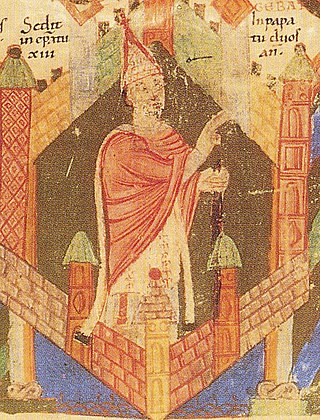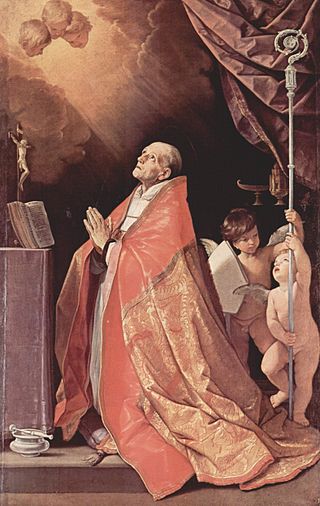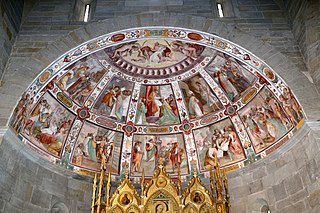
Pope Victor II, born Gebhard of Dollnstein-Hirschberg, was the head of the Catholic Church and ruler of the Papal States from 13 April 1055 until his death in 1057. Victor II was one of a series of German-born popes who led the Gregorian Reform.

Mino da Fiesole, also known as Mino di Giovanni, was an Italian Renaissance sculptor from Poppi, Tuscany. He is noted for his portrait busts.

Saint Brigid of Kildare or Saint Brigid of Ireland is the patroness saint of Ireland, and one of its three national saints along with Patrick and Columba. According to medieval Irish hagiographies, she was an abbess who founded the important abbey of Kildare, as well as several other monasteries of nuns. There are few documented historical facts about her, and her hagiographies are mainly anecdotes and miracle tales, some of which are Christianisations of hero tales from Irish mythology. They say Brigid was the daughter of an Irish clan chief and an enslaved Christian woman, and was fostered in a druid's household before becoming a consecrated virgin. She is patroness of many things, including poetry, learning, healing, protection, blacksmithing, livestock and dairy production. In her honour, a perpetual fire was kept burning at Kildare for centuries.

Fiesole is a town and comune of the Metropolitan City of Florence in the Italian region of Tuscany, on a scenic height above Florence, 5 km northeast of that city. It has structures dating to Etruscan and Roman times.

Antoninus of Florence, was an Italian Dominican friar who served as Archbishop of Florence in the 15th century. He is venerated as a saint in the Catholic Church.

The House of Corsini is the name of an old and influential Italian princely family, originally from Florence, whose members were elected to many important political and ecclesiastical positions, including that of a Pope.

Andrea Corsini was an Italian Catholic prelate and professed member from the Carmelites who served as the Bishop of Fiesole from 1349 until his death.

Bobbio Abbey is a monastery founded by Irish Saint Columbanus in 614, around which later grew up the town of Bobbio, in the province of Piacenza, Emilia-Romagna, Italy. It is dedicated to Saint Columbanus. It was famous as a centre of resistance to Arianism and as one of the greatest libraries in the Middle Ages. The abbey was dissolved under the French administration in 1803, although many of the buildings remain in other uses.
Andrew the Scot was the Irish-born student and assistant of Donatus of Fiesole. He served as archdeacon of Fiesole under Bishop Donatus.

The Diocese of Fiesole is a Latin diocese of the Catholic Church in Tuscany, central Italy, whose episcopal see is the city of Fiesole. Fiesole was directly subject to the pope until 1420, when the archdiocese of Florence was created and Fiesole was made one of its suffragan bishops. It is still a suffragan of the Metropolitan Archbishopric of Florence.

The Diocese of Volterra is a Latin diocese of the Catholic Church in Tuscany, central Italy. It is a suffragan of the Archdiocese of Pisa.

The Diocese of Pistoia is a Latin diocese of the Catholic Church located in the Province of Florence. It has existed since the third century. From 1653 to 1954, the historic diocese was the diocese of Pistoia and Prato. The Diocese of Prato has been separate from 1954. The diocese is a suffragan of the archdiocese of Florence.

The diocese of Cortona was a Roman Catholic ecclesiastical territory in central Italy, which existed from 1325 to 1986. It was immediately subject to the Holy See.

The Diocese of Arezzo-Cortona-Sansepolcro is a Latin diocese of the Catholic Church. It has existed since 1986. In that year the historic diocese of Arezzo was combined with the diocese of Cortona and the diocese of Sansepolcro, the enlarged diocese being suffragan of the archdiocese of Florence.

Saint Romulus of Fiesole was bishop of Fiesole during the 1st century. He is venerated as the patron saint of Fiesole, Italy. Romulus was probably a local deacon, priest, or bishop of the 1st century.

Saint Donatus of Arezzo is the patron saint of Arezzo, and considered a bishop of the city.
San Donato is the Spanish and Italian form of Saint Donatus. It can refer to:
St. Bridget of Fiesole is an Irish Saint whose festival is celebrated in Italy on 1 February.

The Diocesan Seminary of Fiesole is a former Roman Catholic seminary in Fiesole, Italy. Founded in the 17th century, the seminary was run by the Diocese of Fiesole until it was closed in 1970. Today, the seminary retains several pieces of historically significant art and library collections.

The Piazza Madonna is a tempera on panel painting, dating to 1474-1486 and held in Pistoia Cathedral.

















